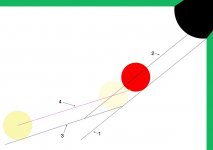Don't look for it young Skywalker, look at what will allow it to jump out and hit you in the face. The pocket, and the two balls will allow you to gather enough information to rely on past experience and similar shots that you've successfully pocketed and before you know it you have a lightbulb moment and it all starts making sense.
I had real issues with low blacks off their spot as a kid. Once I stopped trying to find my line of aim and just looking at the balls relationship to the pocket... Or angle as some call it then the line of sin became clear.
This is almost exactly how I aim most shots. It's all about seeing the angles to me. If I'm not seeing the correct angles I struggle mightily, but once they start "jumping out at me", aiming suddenly seems ridiculously easy. At that point, however, I still have to deal with the problem of delivering the CB along that line so that it ends up in the ghost ball position.
I find it is easiest to shoot directly at a fine point rather than trying to stroke perfectly along a line, or to aim a whole ball at another ball. So, once I see the correct shot line, I look at the OB for any reference marks that the shot line goes right through. The easiest ones to find are the reflections of the table lights on the OB.
For example, on a given shot I might notice that the shot line I am seeing goes through the space between the two reflections on the right side, but a little off center (maybe a bit closer to the inner one). I fix my gaze on that spot and aim directly at it like I am aiming a rifle at it. The cut now feels like a straight in shot to me directly to that point, which it is in essence. To me, this takes the guesswork out of aiming and it becomes purely objective.
Here's a crude diagram I made showing how I use various reference lines to see the angle and aim the shot, in this case cheating the pocket to the right. Once I can clearly see the shot line (line #4), I just find the spot on the OB that is on that line (the little green asterisk), fire directly at it, and the OB slices into the pocket. If the shot is a half ball hit, I just shoot directly at the edge of the OB. If it's a cut over 30º, I will look at how far away the shot line is from the edge of the OB and shoot at that point, or maybe at a point on the rail or in the room behind it if the angle is more extreme.
This may sound complicated, but it is not at all. I see the angle, sight along the leg of the angle that is the shot line, pick out a spot that the line goes through and fire right at that spot like it was straight in. Of course, I still have to deliver a straight stroke, allow for CIT, deflection, and all that jazz, so there is still feel involved, but the actual sighting of the shot seems about as objective as it gets.
Now, a certain somebody will surely come along in a minute or so and tell me I don't understand the meaning of the word "objective", and will provide a definition straight out of Webster, but I won't be reading it because I will be downstairs objectively shooting balls into holes.

